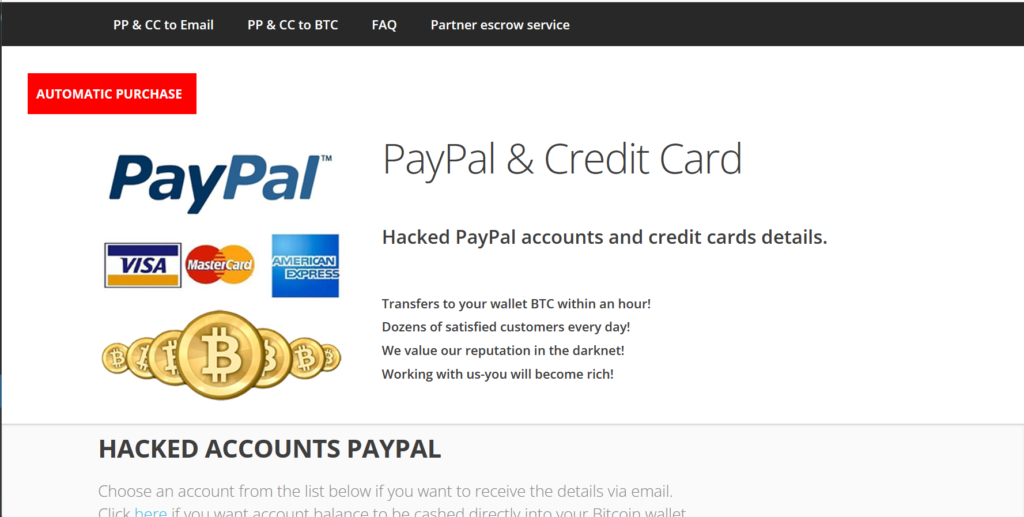Table of Contents
TogglePayPal & Credit Card – TOR Scam Report (1)
Onion Link:
Scam Report Date: 2024/05/01
Client Scam Report Breakdown
Original Report Summary:
This client report involves a scam surrounding the purchase of hacked PayPal accounts and credit card details, where the buyer paid but received no response from the seller. The scam begins with the seller advertising various fraudulent services, such as converting PayPal or credit card balances into Bitcoin (BTC) and promising fast transfers to a cryptocurrency wallet within an hour. The seller claimed to have “dozens of satisfied customers every day” and emphasized their reputation in the darknet. The promise of such illicit services appeared convincing to the client, leading them to complete a transaction. However, after paying the required fee, the seller ceased communication entirely, leaving the buyer without the purchased goods or any further responses.
Citing the original scam report, “After paying the money, the seller did not respond at all,” we see a classic example of a “non-delivery scam” where the fraudster takes payment but fails to provide the promised services or products. The advertised services, such as hacked PayPal accounts and credit card details, are typical in darknet marketplaces where illegal goods and services are often promoted with false guarantees of reliability and customer satisfaction. In this scenario, the client was misled by the false promises and manipulated into paying upfront for goods that were never delivered.
Defining the Fraudulent Services
The site offered a range of illegal services, including hacked PayPal accounts and dumps of credit card information (known as “dumps cards”), which the buyer could either receive via email or have the balance transferred directly to a Bitcoin wallet. The seller also charged an additional $10 fee to transfer the balance to Bitcoin, falsely claiming that the fee would be included at checkout. Moreover, the seller promised extras such as login credentials, a “safe cashing out guide,” and Socks5, a proxy server that could be used to mask the buyer’s identity during online transactions.
In this context, the term “dumps” refers to stolen credit card data, typically including the card number, expiration date, cardholder name, and other relevant details needed to use the card for fraudulent purchases or withdrawals. The “Socks5” proxy server is a common tool used in darknet activities to hide a user’s IP address, adding an extra layer of anonymity for both the buyer and seller. The offer of a “safe cashing out guide” also plays into the buyer’s fear of getting caught, creating a false sense of security and making the scam appear more legitimate. Unfortunately, none of these promised services materialized after the payment was made, making this a well-organized scam that preys on the buyer’s desire for anonymity and illicit financial gain.
Breakdown of the Scam Communication and Non-Response
The client’s primary issue in the scam report revolves around the seller’s complete lack of response after receiving payment. This is a classic tactic in online fraud, particularly in anonymous marketplaces like those on the darknet. Scammers often use enticing language to build trust, claiming “dozens of satisfied customers every day” and asserting their reputation in the illegal marketplace. However, once payment is made, the scammer either vanishes or continues to stall with excuses to delay delivery. In this case, the seller simply ceased all communication, leaving the buyer with no recourse.
This kind of non-response scam highlights the importance of the anonymity and lack of accountability inherent in darknet transactions. The client’s experience reflects a common tactic where the scammer creates an illusion of professionalism and reliability with promises of detailed product information and added-value services like a cashing-out guide or Socks5 proxies. Yet, as seen in the original report, once payment was made, the buyer was ghosted, which is a hallmark of darknet fraud operations. This failure to deliver, combined with the disappearance of the seller, demonstrates how scammers manipulate their victims with fraudulent promises before severing communication, often leaving buyers with no way to reclaim their lost funds.







